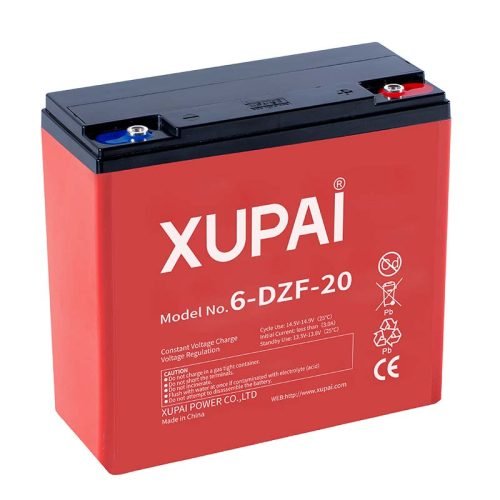Welcome to our premium 12V 20Ah lead-acid battery, designed specifically for electric vehicles. Engineered for reliability, durability, and high performance, this battery ensures your ride is smooth, powerful, and long-lasting. Below are the detailed specifications and reasons why this battery is the perfect choice for you.


Operating Temperature:
Self-Discharge Rate (20°C): >85% capacity retained after 3 months
Charging Voltage:
Discharge Current: 3.6 I₂ (A) Charge Current: 0.15 C₂ (A)
| Discharge Rate | Current | Final Voltage | Capacity |
|---|---|---|---|
| 3 Hours | 6.70A | 10.5V | ≥ 21Ah |
| 5 Hours | 4.00A | 10.5V | ≥ 22.5Ah |
| 10 Hours | 2.00A | 10.5V | ≥ 25Ah |
| 20 Hours | 1.00A | 10.5V | ≥ 30Ah |
The following table lists relevant models that use the 12V 20Ah sealed lead-acid (SLA) battery, either singly or in series for electric bicycles, electric motorcycles, or mobility scooters. These batteries are often used in budget-friendly, older, or mobility-focused models.
| Brand | Model Examples | Context/Application |
|---|---|---|
| Super 73 | S1, R-Series (older/budget models) | 48V systems using 4×12V 20Ah batteries in series. |
| Aventon | Pace 350, utility/rental models | Budget e-bikes with 36V/48V SLA setups. |
| Zip’r Mobility | Zip’r Roo, Zip’r 3 Traveler | Mobility scooters with 12V 20Ah in 24V configurations. |
| Amigo Mobility | Travel Mate, Deluxe | Mobility scooters using 12V 20Ah in 24V systems. |
| Pride Mobility | Go-Go Elite Traveller, Victory 10 | Mobility scooters with 12V 20Ah in 24V setups. |
| Schwinn | S180, S400, older electric scooters | 24V/36V systems for budget scooters and e-bikes. |
| Currie Technologies (eZip) | eZip 500, eZip 750, Trailz | Budget e-bikes/scooters with 24V/36V SLA setups. |
| Mongoose | CX24V450, electric dirt bikes/scooters | Youth-oriented scooters/bikes with 24V/36V systems. |
| Electric Mobility (Rascal) | Rascal 600, Rascal Turnabout | Mobility scooters with 12V 20Ah in 24V/36V setups. |
| Drive Medical | Scout Spitfire, Phoenix HD | Mobility scooters using 12V 20Ah in 24V configurations. |
| Golden Technologies | Buzzaround XL, LiteRider | Mobility scooters with 12V 20Ah in 24V systems. |
| Merits Health | Pioneer 3, Silverado | Mobility scooters using 12V 20Ah in 24V/36V setups. |
| Hoveround | MPV5, Teknique XHD | Mobility scooters with 12V 20Ah in 24V configurations. |
| Shoprider | Sprinter XL4, Echo | Mobility scooters using 12V 20Ah in 24V systems. |
| EcoReco | M5, older electric scooter models | Budget scooters with 24V/36V SLA setups. |
| X-Treme Scooters | X-360, X-250 | Electric scooters with 24V/36V using 12V 20Ah batteries. |
| Mega Motion | Storm, Ninja | Mobility scooters with 12V 20Ah in 24V configurations. |
| Joyor | A3, F3 (older models) | Budget electric scooters with 24V/36V SLA systems. |
| Apollo | City, older electric scooter models | Scooters with 24V/36V setups using 12V 20Ah batteries. |
| TDPRO | Generic e-bikes, ATVs, go-karts | Custom/aftermarket vehicles with 12V 20Ah in 24V–48V. |
Voltage Requirements: Electric bicycles and motorcycles often require higher voltages (24V, 36V, 48V, or 72V), achieved by connecting multiple 12V 20Ah batteries in series. For example, a 48V system uses four 12V 20Ah batteries.
Fitment Check: Ensure the battery’s dimensions (180 × 76 × 170 mm) and terminal type (8.8-M5, copper) match the vehicle’s battery compartment and wiring.
Model-Specific Verification: Many brands have transitioned to lithium-ion batteries in newer models. The 12V 20Ah SLA battery is more common in older models, budget lines, or mobility scooters.
Aftermarket Compatibility: Brands like TDPRO and WPHMOTO provide 12V 20Ah SLA batteries for generic or custom electric bikes, scooters, ATVs, and go-karts, indicating broad applicability.
To confirm compatibility, check your vehicle’s specifications for battery type, voltage, capacity, and dimensions. If you have a specific model in mind, provide its details, and we can help verify compatibility further!
Before using the product, please read the user manual carefully.
For brand-new batteries or those that have been unused for a long time, please use them before charging. During the first five uses, charge the battery only after the power has been reduced by more than 70%.
Make sure the battery is installed securely to avoid damage from vibrations while riding.
Each time you ride, avoid draining the battery completely. Develop the habit of charging in time, keeping the battery as close to full as possible.
Charging: In winter, perform a float charge for 4 hours; in summer, 2 hours. It’s best to use a high-quality charger with a pulse function that matches the battery. Do not charge in direct sunlight or in a hot, enclosed, and poorly ventilated space.
If your rides usually consume less than 70% of the battery’s capacity, perform a deep discharge (over 70%) at least once a month.
Always use the original charger that came with the battery. Do not replace the charger at will, and do not remove the speed limiter on the controller, as these actions can shorten the battery’s lifespan.
Regularly check the battery’s connection wiring to ensure it’s secure. Loose wiring may cause a short circuit and create safety hazards.
If you notice a decrease in battery capacity, first visit your local inspection station to determine the cause. If needed, maintenance can help improve the battery’s performance.
12‑month limited warranty against manufacturing defects. Technical support available for installation and charging best practices.
Our 12V 20Ah lead-acid battery is crafted with precision and care, using the latest technology and high-quality materials to provide unmatched performance for your electric vehicle. Power up your ride with confidence and enjoy the journey!
One year from the date of shipment



Tell us your application, voltage/capacity, target quantity, and delivery terms. Our team will reply within 24 hours.